Answered step by step
Verified Expert Solution
Question
1 Approved Answer
could you please help me with this? that's all i have about this experiment Preparation 1. Check that you have the following solutions present at
could you please help me with this? 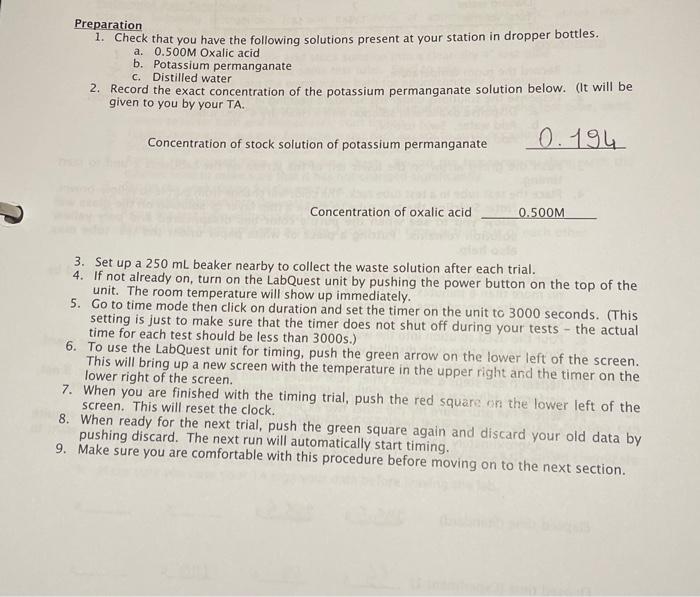
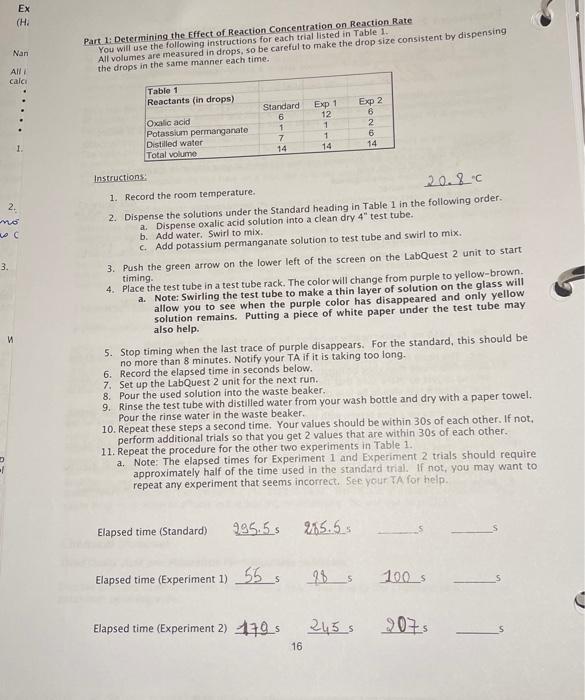
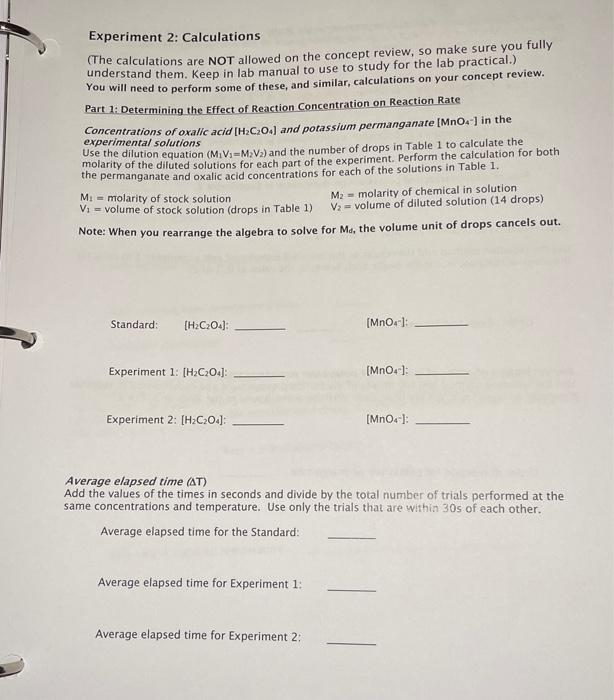
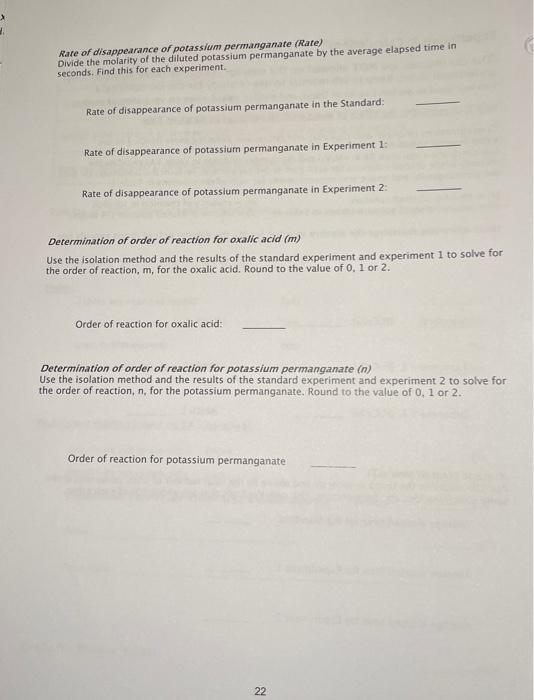
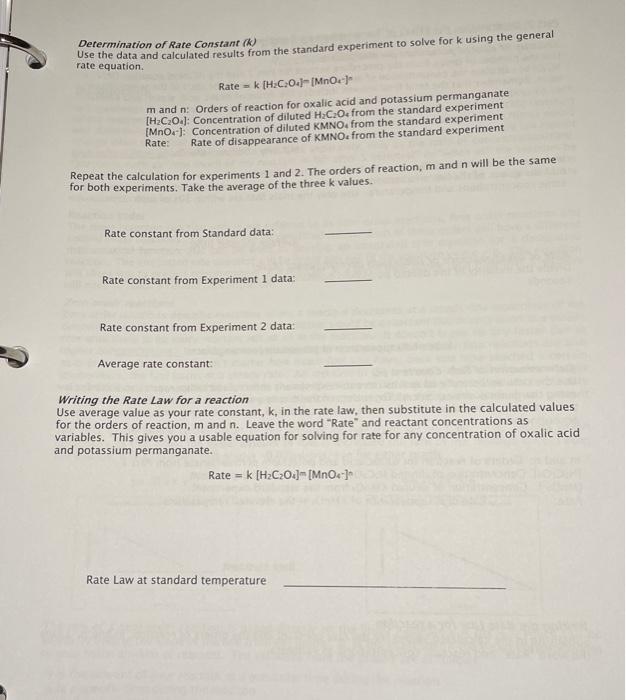





that's all i have about this experiment
Preparation 1. Check that you have the following solutions present at your station in dropper bottles. a. 0.500M Oxalic acid b. Potassium permanganate c. Distilled water 2. Record the exact concentration of the potassium permanganate solution below. (It will be given to you by your TA. Concentration of stock solution of potassium permanganate 0.194 Concentration of oxalic acid 0.500M 3. Set up a 250mL beaker nearby to collect the waste solution after each trial. 4. If not already on, turn on the LabQuest unit by pushing the power button on the top of unit. The room temperature will show up immediately. 5. Go to time mode then click on duration and set the timer on the unit to 3000 seconds. (This setting is just to make sure that the timer does not shut off during your tests - the actual time for each test should be less than 3000 s.) 6. To use the LabQuest unit for timing, push the green arrow on the lower left of the screen. This will bring up a new screen with the temperature in the upper right and the timer on the lower right of the screen. 7. When you are finished with the timing trial, push the red square on the lower left of the screen. This will reset the clock. 8. When ready for the next trial, push the green square again and discard your old data by pushing discard. The next run will automatically start timing. 9. Make sure you are comfortable with this procedure before moving on to the next section. Part.1: Determining the Effect of Reaction Concentration on Reaction Rate You will use the following instructions for each trial listed in Table 1. All volumes are measured in drops, so be careful to make the drop size consistent by dispensing the drops in the same manner each time. Insrauctionsi 1. Record the room temperature. 2. Dispense the solutions under the Standard heading in Table 1 in the following order. a. Dispense oxalic acid solution into a clean dry 4 test tube. b. Add water. Swirl to mix. c. Add potassium permanganate solution to test tube and swirl to mix. 3. Push the green arrow on the lower left of the screen on the LabQuest 2 unit to start timing. 4. Place the test tube in a test tube rack. The color will change from purple to yellow-brown. a. Note: Swirling the test tube to make a thin layer of solution on the glass will allow you to see when the purple color has disappeared and only yellow solution remains. Putting a piece of white paper under the test tube may: also help. 5. Stop timing when the last trace of purple disappears. For the standard, this should be no more than 8 minutes. Notify your TA if it is taking too long. 6. Record the elapsed time in seconds below. 7. Set up the LabQuest 2 unit for the next run. 8. Pour the used solution into the waste beaker. 9. Rinse the test tube with distilled water from your wash bottle and dry with a paper towel. Pour the rinse water in the waste beaker. 10. Repeat these steps a second time. Your values should be within 30 s of each other. If not, perform additional trials so that you get 2 values that are within 305 of each other. 11. Repeat the procedure for the other two experiments in Table 1. a. Note: The elapsed times for Experiment 1 and Experiment 2 trials should require approximately half of the time used in the standard trial. If not, you may want to repeat any experiment that seems incorrect. See ycur TA for help. Elapsed time (Standard) 995.5s2,55.5.5 Elapsed time (Experiment 1) 55 q 50s5s5 Elapsed time (Experiment 2) 1705 s 5 s 535 s 5 s 16 Experiment 2: Calculations (The calculations are NOT allowed on the concept review, so make sure you fully understand them. Keep in lab manual to use to study for the lab practical.) You will need to perform some of these, and similar, calculations on your concept review. Part 1: Determining the Effect of Reaction Concentration on Reaction Rate Concentrations of oxalic acid [H2C2O4] and potassium permanganate [MnO4] in the experimental solutions Use the dilution equation (M1V1=M2V2) and the number of drops in Table 1 to calculate the molarity of the diluted solutions for each part of the experiment. Perform the calculation for both the permanganate and oxalic acid concentrations for each of the solutions in Table 1. M1= molarity of stock solution M2= molarity of chemical in solution V1= volume of stock solution (drops in Table 1) V2= volume of diluted solution (14 drops) Note: When you rearrange the algebra to solve for Md, the volume unit of drops cancels out. Standard: [H2C2O4] : [MnO4]: Experiment 1: [H2C2O4] : [MnO4] Experiment 2: [H2C2O4] : [MnO4] Average elapsed time ( T ) Add the values of the times in seconds and divide by the total number of trials performed at the same concentrations and temperature. Use only the trials that are within 30 s of each other. Average elapsed time for the Standard: Average elapsed time for Experiment 1: Average elapsed time for Experiment 2: Rate of disappearance of potassium permanganate (Rate) Divide the molarity of the diluted potassium permanganate by the average elapsed time in seconds. Find this for each experiment. Rate of disappearance of potassium permanganate in the Standard: Rate of disappearance of potassium permanganate in Experiment 1 : Rate of disappearance of potassium permanganate in Experiment. 2 : Determination of order of reaction for oxalic acid (m) Use the isolation method and the results of the standard experiment and experiment 1 to solve for the order of reaction, m, for the oxalic acid. Round to the value of 0,1 or 2 . Order of reaction for oxalic acid: Determination of order of reaction for potassium permanganate (n) Use the isolation method and the results of the standard experiment and experiment 2 to solve for the order of reaction, n, for the potassium permanganate. Round to the value of 0,1 or 2. Determination of Rate Constant (k) Use the data and calculated results from the standard experiment to solve for k using the general rate equation. Rate=k[H2C2O4][MnO4]n m and n : Orders of reaction for oxalic acid and potassium permanganate [ H2C2O4] : Concentration of diluted H2C2O4 from the standard experiment [ MnO4-]: Concentration of diluted KMNO4 from the standard experiment Rate: Rate of disappearance of KMNO from the standard experiment Repeat the calculation for experiments 1 and 2 . The orders of reaction, m and n will be the same for both experiments. Take the average of the three k values. Rate constant from Standard data: Rate constant from Experiment 1 data: Rate constant from Experiment 2 data: Average rate constant: Writing the Rate Law for a reaction Use average value as your rate constant, k, in the rate law, then substitute in the calculated values for the orders of reaction, m and n. Leave the word "Rate" and reactant concentrations as variables. This gives you a usable equation for solving for rate for any concentration of oxalic acid and potassium permanganate. Rate=k[H2C2O4]m[MnO4]n Rate Law at standard temperature Preparation 1. Check that you have the following solutions present at your station in dropper bottles. a. 0.500M Oxalic acid b. Potassium permanganate c. Distilled water 2. Record the exact concentration of the potassium permanganate solution below. (It will be given to you by your TA. Concentration of stock solution of potassium permanganate 0.194 Concentration of oxalic acid 0.500M 3. Set up a 250mL beaker nearby to collect the waste solution after each trial. 4. If not already on, turn on the LabQuest unit by pushing the power button on the top of unit. The room temperature will show up immediately. 5. Go to time mode then click on duration and set the timer on the unit to 3000 seconds. (This setting is just to make sure that the timer does not shut off during your tests - the actual time for each test should be less than 3000 s.) 6. To use the LabQuest unit for timing, push the green arrow on the lower left of the screen. This will bring up a new screen with the temperature in the upper right and the timer on the lower right of the screen. 7. When you are finished with the timing trial, push the red square on the lower left of the screen. This will reset the clock. 8. When ready for the next trial, push the green square again and discard your old data by pushing discard. The next run will automatically start timing. 9. Make sure you are comfortable with this procedure before moving on to the next section. Part.1: Determining the Effect of Reaction Concentration on Reaction Rate You will use the following instructions for each trial listed in Table 1. All volumes are measured in drops, so be careful to make the drop size consistent by dispensing the drops in the same manner each time. Insrauctionsi 1. Record the room temperature. 2. Dispense the solutions under the Standard heading in Table 1 in the following order. a. Dispense oxalic acid solution into a clean dry 4 test tube. b. Add water. Swirl to mix. c. Add potassium permanganate solution to test tube and swirl to mix. 3. Push the green arrow on the lower left of the screen on the LabQuest 2 unit to start timing. 4. Place the test tube in a test tube rack. The color will change from purple to yellow-brown. a. Note: Swirling the test tube to make a thin layer of solution on the glass will allow you to see when the purple color has disappeared and only yellow solution remains. Putting a piece of white paper under the test tube may: also help. 5. Stop timing when the last trace of purple disappears. For the standard, this should be no more than 8 minutes. Notify your TA if it is taking too long. 6. Record the elapsed time in seconds below. 7. Set up the LabQuest 2 unit for the next run. 8. Pour the used solution into the waste beaker. 9. Rinse the test tube with distilled water from your wash bottle and dry with a paper towel. Pour the rinse water in the waste beaker. 10. Repeat these steps a second time. Your values should be within 30 s of each other. If not, perform additional trials so that you get 2 values that are within 305 of each other. 11. Repeat the procedure for the other two experiments in Table 1. a. Note: The elapsed times for Experiment 1 and Experiment 2 trials should require approximately half of the time used in the standard trial. If not, you may want to repeat any experiment that seems incorrect. See ycur TA for help. Elapsed time (Standard) 995.5s2,55.5.5 Elapsed time (Experiment 1) 55 q 50s5s5 Elapsed time (Experiment 2) 1705 s 5 s 535 s 5 s 16 Experiment 2: Calculations (The calculations are NOT allowed on the concept review, so make sure you fully understand them. Keep in lab manual to use to study for the lab practical.) You will need to perform some of these, and similar, calculations on your concept review. Part 1: Determining the Effect of Reaction Concentration on Reaction Rate Concentrations of oxalic acid [H2C2O4] and potassium permanganate [MnO4] in the experimental solutions Use the dilution equation (M1V1=M2V2) and the number of drops in Table 1 to calculate the molarity of the diluted solutions for each part of the experiment. Perform the calculation for both the permanganate and oxalic acid concentrations for each of the solutions in Table 1. M1= molarity of stock solution M2= molarity of chemical in solution V1= volume of stock solution (drops in Table 1) V2= volume of diluted solution (14 drops) Note: When you rearrange the algebra to solve for Md, the volume unit of drops cancels out. Standard: [H2C2O4] : [MnO4]: Experiment 1: [H2C2O4] : [MnO4] Experiment 2: [H2C2O4] : [MnO4] Average elapsed time ( T ) Add the values of the times in seconds and divide by the total number of trials performed at the same concentrations and temperature. Use only the trials that are within 30 s of each other. Average elapsed time for the Standard: Average elapsed time for Experiment 1: Average elapsed time for Experiment 2: Rate of disappearance of potassium permanganate (Rate) Divide the molarity of the diluted potassium permanganate by the average elapsed time in seconds. Find this for each experiment. Rate of disappearance of potassium permanganate in the Standard: Rate of disappearance of potassium permanganate in Experiment 1 : Rate of disappearance of potassium permanganate in Experiment. 2 : Determination of order of reaction for oxalic acid (m) Use the isolation method and the results of the standard experiment and experiment 1 to solve for the order of reaction, m, for the oxalic acid. Round to the value of 0,1 or 2 . Order of reaction for oxalic acid: Determination of order of reaction for potassium permanganate (n) Use the isolation method and the results of the standard experiment and experiment 2 to solve for the order of reaction, n, for the potassium permanganate. Round to the value of 0,1 or 2. Determination of Rate Constant (k) Use the data and calculated results from the standard experiment to solve for k using the general rate equation. Rate=k[H2C2O4][MnO4]n m and n : Orders of reaction for oxalic acid and potassium permanganate [ H2C2O4] : Concentration of diluted H2C2O4 from the standard experiment [ MnO4-]: Concentration of diluted KMNO4 from the standard experiment Rate: Rate of disappearance of KMNO from the standard experiment Repeat the calculation for experiments 1 and 2 . The orders of reaction, m and n will be the same for both experiments. Take the average of the three k values. Rate constant from Standard data: Rate constant from Experiment 1 data: Rate constant from Experiment 2 data: Average rate constant: Writing the Rate Law for a reaction Use average value as your rate constant, k, in the rate law, then substitute in the calculated values for the orders of reaction, m and n. Leave the word "Rate" and reactant concentrations as variables. This gives you a usable equation for solving for rate for any concentration of oxalic acid and potassium permanganate. Rate=k[H2C2O4]m[MnO4]n Rate Law at standard temperature Step by Step Solution
There are 3 Steps involved in it
Step: 1

Get Instant Access to Expert-Tailored Solutions
See step-by-step solutions with expert insights and AI powered tools for academic success
Step: 2

Step: 3

Ace Your Homework with AI
Get the answers you need in no time with our AI-driven, step-by-step assistance
Get Started


